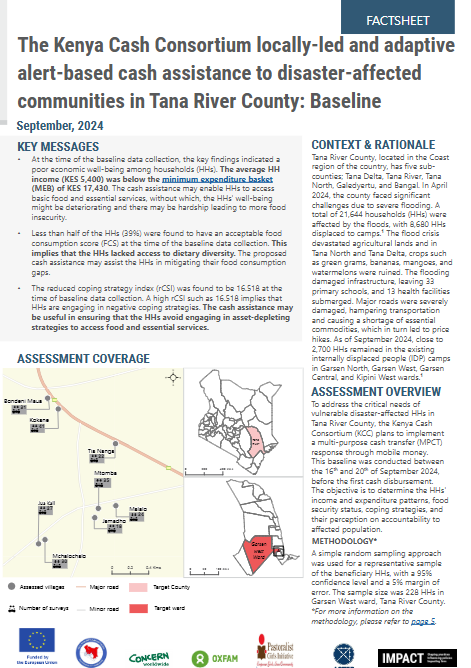ASAL Humanitarian Network (AHN)
BASELINE FINDINGS REVEAL POOR HOUSEHOLD INCOME, HIGH FOOD EXPENDITURE, AND NEGATIVE COPING STRATEGIES IN FLOOD-AFFECTED AREAS OF TANA RIVER COUNTY
Baseline Insights – Locally-Led and Adaptive Alert-Based Cash Assistance to Disaster-Affected Communities in Tana River County
The Kenya Cash Consortium’s baseline assessment highlights the urgent need for multi-purpose cash assistance to improve household income, food security, and resilience in flood-affected communities.
The Baseline Assessment for Locally-Led and Adaptive Alert-Based Cash Assistance to Disaster-Affected Communities in Tana River County was implemented by the Kenya Cash Consortium (KCC) to assess household well-being before the rollout of a multi-purpose cash transfer (MPCT) intervention. Conducted between 16–20 September 2024 by IMPACT Initiatives, the survey covered 228 households in Garsen West Ward, Tana River County, using a simple random sampling approach with a 95% confidence level and 5% margin of error. The baseline measured income, expenditure, food security, coping strategies, and accountability to affected populations.
Findings reveal significant economic vulnerability. The average household income was KES 5,400, well below the Minimum Expenditure Basket (MEB) of KES 19,231, while average expenditure stood at KES 5,234. Nearly all households (99%) had debts averaging KES 9,599, exceeding their income levels. Households spent 73% of their expenditure on food, limiting access to essential services such as health, shelter, and education. None of the surveyed households reported savings, underscoring widespread financial insecurity.
Food security indicators show that only 39% of households had an acceptable Food Consumption Score (FCS), while 80% experienced moderate hunger and 9% reported severe hunger. The Reduced Coping Strategy Index (rCSI) was 16.5, indicating frequent use of negative coping behaviors such as meal reduction and food borrowing. The findings place the majority of households in Crisis (IPC Phase 3) food insecurity conditions.
Despite these challenges, the assessment found strong community preference for mobile money assistance due to its flexibility, accessibility, and security. All respondents (100%) considered this the most suitable delivery mechanism. These baseline insights confirm the critical need for timely, adaptive, and accountable cash assistance to protect livelihoods and restore household resilience in flood-affected regions of Tana River County.
📄 Click the image below to download the full Baseline Factsheet (PDF) and review detailed findings and data tables.

